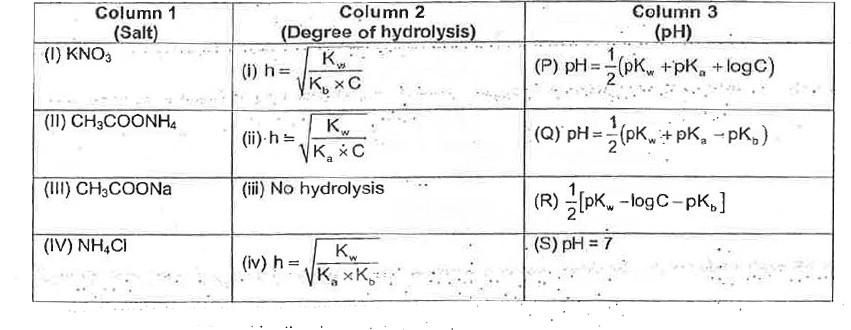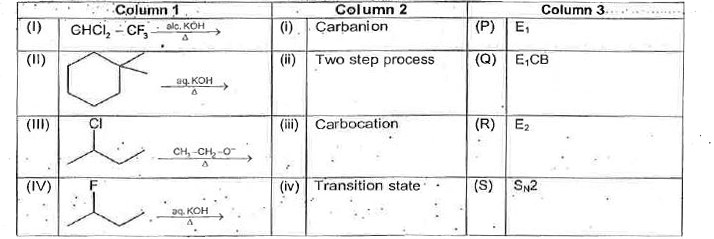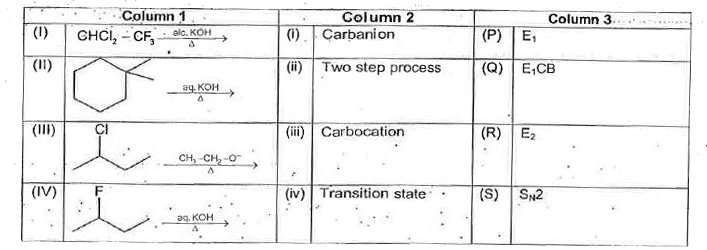1, 2 and 3 by appropriately matching the information given in the three columns of the following table.

The CORRECT combination is:
(I) (i) (Q)
(II) (ii) (P)
(III)(iv)(R)
(III) (iii) (S)
The correct Answer is:D
Topper's Solved these Questions
- LIQUID SOLUTION BOOK - FIITJEECHAPTER - LIQUID SOLUTION EXERCISE - SINGLE INTERGER ANSWER TYPE QUESTIONS
2 Videos
- LIQUID SOLUTION BOOK - FIITJEECHAPTER - LIQUID SOLUTION EXERCISE - ASSIGNMENT PROBLEMS (SUBJECTIVE) level-I (SHORT ANSWER TYPE)
7 Videos
- LIQUID SOLUTION BOOK - FIITJEECHAPTER - LIQUID SOLUTION EXERCISE - EXERCISE
7 Videos
- IONIC EQUILIBRIUM BOOK - FIITJEECHAPTER - IONIC EQUILIBRIUM EXERCISE - SINGLE INTEGER ANSWER QUESTIONS
4 Videos
- NUCLEIC ACID AND VITAMIN BOOK - FIITJEECHAPTER - NUCLEIC ACID AND VITAMIN EXERCISE - ASSIGNMENT PROBLEMS (OBJECTIVE)
15 Videos
Similar Questions
Answer Q 1,2 and 3 by appropriately matching the information given in the columns of the following table .

The CORRECT combination is :
View Solution1, 2, and 3 by appropriately matching the information given in the three columns of the following table.

The only INCORRECT combination is:
View Solution
Knowledge Check
This section contains Three questions. The section contains Two tables (each having 3 columns and 4 rows). Based on each table, there are THREE questions. Each question has FOUR options (A), [B]. [C], and [D]. ONLY ONE of these four options is correct.
Answer Q. 1, 2 and 3 by appropriately matching the information given in the three columns of the following table.
Q The CORRECT combination is:
 A(I)(i)(Q)B(I)(iv)(Q)C(III)(ii)(S)D(IV)(i)(P)
A(I)(i)(Q)B(I)(iv)(Q)C(III)(ii)(S)D(IV)(i)(P)This section contains Three questions. The section contains TWO tables (each having 3 columns and 4 rows). Based on each table, there are THREE questions. Each question has FOUR options (A], [B]. [C], and [D]. ONLY ONE of these four options is correct.
Answer Q.1, 2 and 3 by appropriately matching the information given in the three columns of the following table.
QThe INCORRECT combination is:
 A(II) (i) (S)B(II) (ii) (R)C(iV) (i) (R)D(IV) (R)
A(II) (i) (S)B(II) (ii) (R)C(iV) (i) (R)D(IV) (R)1, 2, and 3 by appropriately matching the information given in the three columns of the following table.

The only CORRECT combination in which the reaction proceeds through radical mechanism is:A[A](I)(iii)(R)B[B] (II) (iii) (Q)C[C] (III) (ii) (P)D[D](IV)(i)(R)
Answer Q 1,2 and 3 by appropriately matching the information given in the columns of the following table .

The CORRECT combination is :
View SolutionThis section contains Three questions. The section contains Two tables (each having 3 columns and 4 rows). Based on each table, there are THREE questions. Each question has FOUR options (A), [B]. [C], and [D]. ONLY ONE of these four options is correct.
Answer Q. 1, 2 and 3 by appropriately matching the information given in the three columns of the following table.
Q Find CORRECT combination:

View SolutionThis section contains Three questions. The section contains Two tables (each having 3 columns and 4 rows). Based on each table, there are THREE questions. Each question has FOUR options (A), [B]. [C], and [D]. ONLY ONE of these four options is correct.
Answer Q. 1, 2 and 3 by appropriately matching the information given in the three columns of the following table.
Q Find CORRECT combination:

View SolutionThis section contains Three questions. The section contains TWO tables (each having 3 columns and 4 rows). Based on each table, there are THREE questions. Each question has FOUR options (A], [B]. [C], and [D]. ONLY ONE of these four options is correct.
Answer Q.1, 2 and 3 by appropriately matching the information given in the three columns of the following table.
QFind the CORRECT combination:

View SolutionThis section contains Three questions. The section contains TWO tables (each having 3 columns and 4 rows). Based on each table, there are THREE questions. Each question has FOUR options (A], [B]. [C], and [D]. ONLY ONE of these four options is correct.
Answer Q.1, 2 and 3 by appropriately matching the information given in the three columns of the following table.
QFind the CORRECT combination:

View Solution
